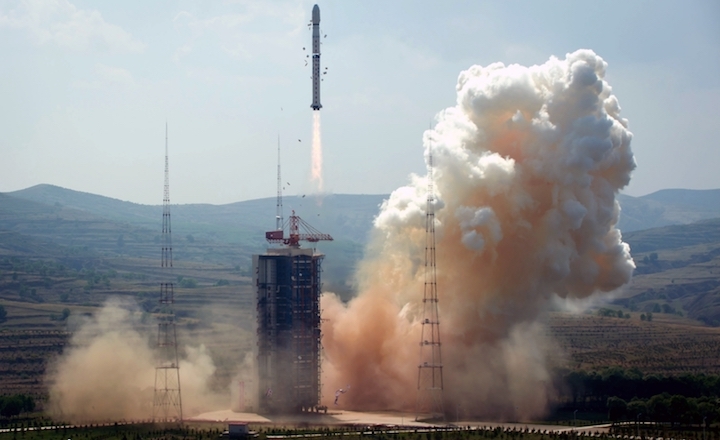31.03.2018

China’s Long March 4C has launched three Gaofen-1 satellites from the Taiyuan Satellites Launch Center’s LC9 Launch Complex. China’s tenth launch of 2018 took place at 03:22 UTC.
The Gaofen civilian high-resolution remote sensing satellites (gao fen = high-resolution) are part of a program that is one of the 16 main programs announced by the State Council in a 15 year plan of Chinese national scientific and technology programs between 2006 and 2020.
This program will become the main civilian Earth observation project of China in the next years, combining the use of satellites as well as airplanes and even stratosphere balloons.
The program was started in 2010 and at least 14 satellites are planned, forming a near-real-time, all-weather, global surveillance network for agricultural planning, disaster relief, environment protection, and security purposes.
The Gaofen-1 satellites are based on the CAST small satellite bus designed and built by China Spacesat Co. Ltd., the commercial subsidiary of CAST, and is equipped with two solar panel wings, each with three solar panels. For observation purposes, GF-1 is equipped with a 2 meter resolution CCD camera, an 8 meter resolution multi-spectrum imager, and a 16 meter resolution wide-field multi-spectrum imager.
Together with the first Gaofen-1 satellites, the three new satellites will be used as an operational constellation.
Each satellite has a launch mass of 805 kg and have an operational life-time of 6 years. The satellites operate on a 3+1 network with the first Gaofen-1 bird, providing a 2 days revisit coverage and a 15 days global coverage by the three new satellites and a 11 days global coverage by the 3+1 network.
With its main commonality matched to the Long March 4B, the first stage has a 24.65 meter length with a 3.35 meter diameter, consuming 183,340 kg of N2O4/UDMH (gross mass of first stage is 193.330 kg).
The vehicle is equipped with a YF-21B engine capable of a ground thrust of 2,971 kN and a ground specific impulse of 2,550 Ns/kg. The second stage has a 10.40 meter length with a 3.35 meter diameter and 38,326 kg, consuming 35,374 kg of N2O4/UDMH.

It includes a YF-22B main engine capable of a vacuum thrust of 742 kN and four YF-23B vernier engines with a vacuum thrust of 47.1 kN (specific impulses of 2,922 Ns/kg and 2,834 Ns/kg, respectively).
The third stage has a 4.93 meter length with a 2.9 meter diameter, consuming 12,814 kg of N2O4/UDMH. Having a gross mass of 14,560 kg, it is equipped with a YF-40 engine capable of a vacuum thrust of 100.8 kN and a specific impulse in vacuum of 2,971 Ns/kg.
Situated in the Kelan County in the northwest part of the Shanxi Province, the Taiyuan Satellite Launch Center (TSLC) is also known by the Wuzhai designation. It is used mainly for polar launches (meteorological, Earth resources and scientific satellites).
The launch center has two single-pad launch complexes, a technical area for rocket and spacecraft preparations, a communications center, a mission command and control center, and a space tracking center.
The stages of the rocket were transported to the launch center by railway and offloaded at a transit station south of the launch complex. They were then transported by road to the technical area for checkout procedures.
The launch vehicles were assembled on the launch pad by using a crane at the top of the umbilical tower to hoist each stage of the vehicle in place. Satellites were airlifted to the Taiyuan Wusu Airport about 300km away, and then transported to the center by road.
The TT&C Centre, also known as Lüliang Command Post, is headquartered in the city of Taiyuan, It has four subordinate radar tracking stations in Yangqu (Shanxi), Lishi (Shanxi), Yulin (Shaanxi), and Hancheng (Shaanxi).
Quelle: NS
